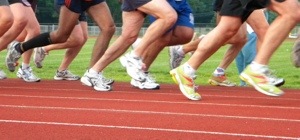Run faster or run more? High intensity training vs. high volume training.

Taken from The Science of Running By Steve Magness. Available at www.ScienceofRunning.com.
In the research literature there has been a trend towards the recommendation of high intensity versus high volume training (Berg, 2003). This is likely a result of the short term nature of research studies. Given the changes that occur with high intensity versus lower intensity and longer duration training, it is not surprising that high intensity training shows greater benefits over only a couple of weeks. This has led to the conclusion that high intensity training is preferential over higher volume to reach the same adaptations. However, it is questionable whether this preference has merit. Seiler and Tønnessen found that elite endurance training consists of about 85% of the training being performed at low to moderate intensities in several different groups of elite endurance athletes (2009). Furthermore, they point out that elite training is more likely to represent optimum training than what is demonstrated in the lab setting because of a likely evolution process of training by elites.
Contrasting the research theory, Esteve-Lanao et al. demonstrated that it was the amount of easy running that impacted running performance over a 10km race, not the amount of high intensity training (2007). The experience of elite endurance athletes also contradicts the research findings that high intensity, low volume training is optimal. As pointed out already it seems that the best runners combine a higher volume of training with some higher intensity training. Due to the high volume of training, the large percentage is low intensity, but the absolute volume of relatively high intensity training still reaches levels of 20mi or more per week (Billat et al., 2003). In a paper by Laursen, he points out two key findings, first, without a background of high volume training, high intensity training can maintain performance, but seldom improve performance (2009).
Secondly, while the adaptations of high intensity and high volume training may be similar, they may occur via two different pathways. Most of the training studies manipulating intensity of training add high intensity work to athlete’s training schedule that have been doing a large volumeof low intensity training. This interaction that high intensity training must be preceded by high volume training is fundamental in popular literature on distance running, but neglected in the research.
Addressing the first point made by Laursen, high intensity training is more beneficial when preceded by what is termed a base in popular literature. In a study by Quinn et al., two different groups performed either continuous exercise or interval training for 12 weeks (2002). At the end of the 12 weeks, the groups switched, so that the continuous group now did 12 weeks of interval training. It was found that the group that did continuous and then interval training improved significantly more in terms of time to exhaustion (15% to 5.3%) and VO2max (7.4% to 3.6%) than the group that did interval and then continuous training. These finding supports the idea that a base of moderate work needs to be established before intense training is done for maximum benefits. This could also explain why in most studies which simply replace a portion of the low to moderate training in their subjects with high intensity training, performance is improved by so much. This interaction of prior training’s impact on training during a study should be taken into consideration when evaluating study results.
According to Laursen, high volume training may signal for adaptations through the calcium-calmodulin pathway, because of the increase in intramuscular Calcium seen in long duration, high volume training (2004) In contrast to this, high intensity training may signal adaptations through the adenosine monophosphate kinase (AMPK) pathway because of the increase in AMP seen following high intensity training. Both of these pathways eventually lead to PGC-1α, which is a transcriptional cofactor that will result in the typical adaptations seen in endurance athletes such as mitochondria biogenesis (Laursen, 2004). Laursen thus concludes that there are two very different ways to achieve similar adaptations. This points to the idea that to maximize these adaptations both stimulus are likely needed, as one pathway may be more difficult to activate than the other depending on the individual and their training status.
In conclusion, it is likely the time course of changes and the length of the research studies which is creating this discrepancy between real world recommendations and findings and the findings in the lab. High intensity training is likely to show quick adaptations, explaining its greater impact on performance within a short period of time. The long term effect of repeated high intensity training is not something that has been researched in the literature. The experience of coaches points to a long block of high intensity training leading to decreased performance, mostly likely due to overtraining (Lydiard, 1998). Lastly, some research points to the idea that high intensity training may need to be preceded by higher volume training to see maximal benefits. This possibility needs to be further researched and considered when evaluating training research.







Interested to observe that there seems to be no mention of injury rates with high intensity V high volume training. From my experience as a physio it would seem that both need to be gradually and incrementally advanced to reduce the risk of over-use injury. In the case of high intensity training, I do also believe ‘burn-out’ to be a factor.
Interested in thoughts of others here….
Interested to observe that there seems to be no mention of injury rates with high intensity V high volume training. From my experience as a physio it would seem that both need to be gradually and incrementally advanced to reduce the risk of over-use injury. In the case of high intensity training, I do also believe ‘burn-out’ to be a factor.
Interested in thoughts of others here….
References?